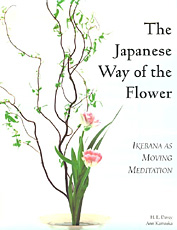According to an old Japanese legend, a young girl came to her local well to draw water, only to discover that a trailing vine had wound itself around the rope that pulled the bucket. Baking in the sunlight, a single blossom had opened itself to the day. The girl savored the flower's beauty for a few moments. Then, in order not to disturb the plant, she walked out of her way to the next well to draw her water. This is an example of union with the "flower heart."
In this sturdy and illuminating examination of kado, the Japanese art of flower arrangement, H. E. Davey, founder and director of the Sennin Foundation Center for Japanese Cultural Arts, and Ann Kameoka, a certified instructor in Ikenobo-style flower arranging, reveal how this way leads to personal transformation. The paperback begins with a history of the art and moves on to an exploration of the relationship between the mind and body of the kado student. The authors have included meditation exercises that can be used with flower arranging. They then present basic flower compositions with color photographs, diagrams, and step-by-step instructions. Sources for flower arrangement supplies are listed in the back of the book.
One of the most poignant chapters zeroes in on the fundamental principles of kado. They include harmony, asymmetrical balance, artlessness, impermanence, and oneness with the universe. Davey and Kameoka note: "What better art than kado to lead us to nonattachment as well as a profound awareness of the transient character of life? Flowers that you have painstakingly arranged will wither and die in a short time." The flower artist or sculptor turns his or her attention to these beauties and, in the process, experiences a unity with the natural world that is transformative.
